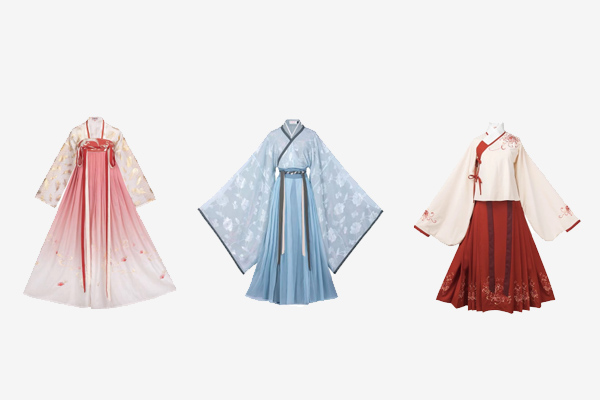All Types of Chinese Style Hanfu

In the contemporary world of fashion, Hanfu, as a traditional Chinese attire, has continuously captivated people’s attention with its unique charm and profound historical and cultural heritage. Hanfu is not merely a garment; it embodies the essence of China’s five-thousand-year-old civilization, carrying forward tradition while embracing innovation. In this article, we will delve into different types of Hanfu, ranging from classical to modern, from formal to casual, showcasing the diversity and allure of Hanfu, as well as its distinctive position in contemporary society. Let us embark on this journey through time together, to appreciate the elegance and charm of Hanfu.
Ruqun
Ruqun” (襦裙) is a traditional two-piece Chinese garment worn by women. It consists of a blouse-like top called “ru” (襦) and a wrap-around skirt called “qun” (裙)
What is Ru?
The ru is the upper garment of the ruqun. It typically features crossed collars, wide sleeves, and a loose fit. The collar can be buttoned or tied at the side, and the sleeves can vary in length and style, ranging from short sleeves to long and flowing ones. The ru is often made from silk or other luxurious fabrics and may be embellished with embroidery, patterns, or decorative elements.
What is Qun?
The qun is the skirt portion of the ruqun. It is a wrap-around skirt that is pleated and tied at the waist with long sashes or ribbons. The length of the qun can vary, ranging from ankle-length to floor-length, depending on the wearer’s preference and the occasion. Qun skirts are typically made from silk or other lightweight fabrics and may feature intricate patterns or designs along the hemline.
Types of Run
Here are some common types or variations of Ruqun (襦裙), a traditional Chinese two-piece garment:
Cross-collar Ruqun
Cross-collar Ruqun, known for its elegant cross-collar upper garment, reflects the refinement and grace of ancient Chinese clothing. This style often includes a long, flowing skirt paired with a form-fitting cross-collar top, creating a harmonious and balanced silhouette. During the Han and Song Dynasties, Cross-collar Ruqun was a popular choice for women of various social statuses, symbolizing both modesty and sophistication.
High-waisted Ruqun
The High-waisted Ruqun, characterized by its unique high waistline, represents a distinctive fashion trend of the Sui, Tang, and Five Dynasties period. With the skirt’s waistline positioned higher, often around the chest area, this style accentuates the wearer’s figure and exudes a sense of elegance and femininity. Though lacking archaeological evidence, historical records and literary works vividly depict the popularity and influence of High-waisted Ruqun during that era.
Cross-lapel Ruqun
Originating from the Wei and Jin Dynasties, Cross-lapel Ruqun features a straight-collared upper garment with symmetrical lapels, presenting a balanced and symmetrical aesthetic. This style, known for its practicality and comfort, was favored by women for its versatility and suitability for various occasions, from daily activities to social gatherings. Cross-lapel Ruqun epitomizes the timeless charm of traditional Han Chinese attire, reflecting the fusion of grace and functionality.
Aoqun and Qun
Aoqun and Qun, prevalent during the Ming Dynasty, showcase the intricate craftsmanship and rich cultural heritage of traditional Hanfu. The Ao (short jacket) is often adorned with elaborate embroidery and intricate patterns, symbolizing prosperity and auspiciousness. Paired with the Qun (skirt), which can feature various styles such as horse-face skirts or pleated skirts, this ensemble reflects the Ming Dynasty’s emphasis on elegance and refinement in women’s attire.
Horse-face Skirt
The horse-face skirt, also known as the “horse-face pleated skirt”, is a kind of dress worn by Han women in ancient China, and is named because of its shape similar to the horse face. The horse-face skirt appeared in the Han Dynasty, reached its peak in the Ming Dynasty, and lasted until the end of the Qing Dynasty. This kind of skirt is very popular among Han women in ancient times and has unique style and characteristics.
The appearance of the horse-face skirt.
The structure of the horse face skirt is unique, and there are four skirt doors before and after it, which coincide in pairs to form a horse face. This design is not only beautiful, but also very practical. In ancient times, people usually put the horse-face skirt in the long gown, long skirt and other clothes to form a complete set of clothes.

